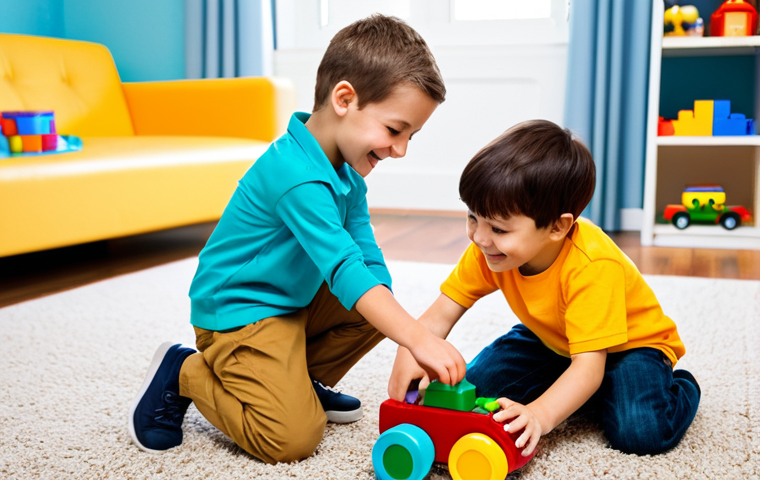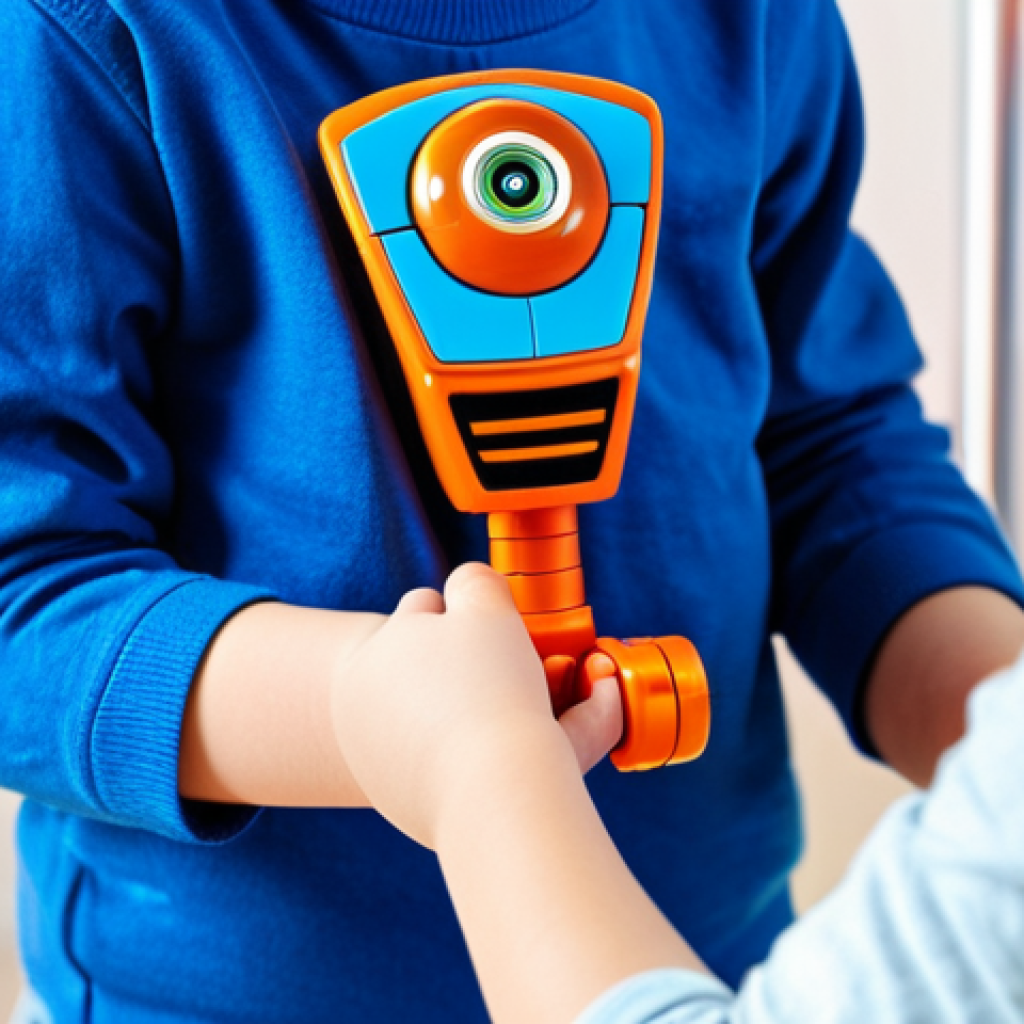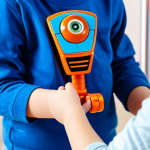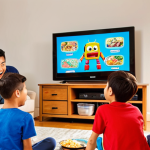Have you ever seen a child’s eyes light up, absolutely bursting with excitement, as they transform a sleek vehicle into a mighty dinosaur? There’s a special kind of magic in it, isn’t there?
It’s not just about pushing buttons; it’s about imagination taking flight, problem-solving, and bringing beloved characters to life right in their own hands.
And when it comes to capturing that pure, unadulterated joy, the ‘Hello Carbot Tyracong and Friends’ series stands out. I’ve personally watched how these figures captivate young minds, offering so much more than mere playtime.
In a world increasingly dominated by screens, it’s refreshing to see a toy line that masterfully bridges the gap between vibrant storytelling and tangible, hands-on play.
This isn’t just about a fleeting trend; it reflects a deeper shift in how we view children’s entertainment – moving towards engaging narratives that foster creativity and critical thinking.
As we look ahead, the future of toys like Tyracong is fascinating, pointing towards even more immersive experiences that combine physical interaction with evolving digital possibilities, all while grounding children in the timeless joy of imaginative adventure.
So, how exactly does this beloved series achieve such a perfect balance, and what can we expect next from the world of transforming heroes and prehistoric pals?
Let’s dive deeper below!
The Allure of Dynamic Play: Transforming Figures and Childhood Imagination

There’s an undeniable magic that happens when a child engages with a toy that can shift its very identity. It’s not just about the mechanics; it’s about the narrative possibilities that burst forth when a seemingly ordinary vehicle unfolds into a powerful dinosaur, or a sleek robot.
As someone who has spent countless hours observing children at play, I’ve come to understand that this isn’t merely entertainment; it’s a profound developmental experience.
The “Hello Carbot Tyracong and Friends” series, in particular, nails this concept, offering a rich tapestry of imaginative scenarios that transcend basic toy functionality.
From the moment a child first grips one of these figures, they’re not just holding plastic; they’re holding a gateway to a world where cars become companions, and prehistoric beasts become protectors.
This inherent flexibility in play is crucial because it allows children to constantly re-evaluate and redefine the object in their hands, fostering a type of cognitive flexibility that is invaluable in their growth.
It’s this dynamic interaction that keeps children coming back, encouraging them to explore new stories, invent new challenges, and continually expand their own creative horizons.
The simple act of transforming a toy becomes a micro-narrative, a moment of invention, and a testament to the boundless nature of a child’s imagination.
1. Unlocking Creative Narratives Through Transformation
The beauty of these transforming toys lies in their ability to act as versatile storytelling props. I’ve witnessed firsthand how a single Carbot figure can become the protagonist in a thrilling chase one minute, and a wise, ancient guardian the next.
This fluid identity encourages children to think beyond fixed roles and to imagine complex storylines where characters evolve and adapt. It’s not just about pressing a button; it’s about a mental shift, a cognitive exercise in seeing potential beyond the obvious.
For example, a child might initially see Tyracong as just a dinosaur, but once they transform him into a car, a whole new set of play possibilities emerges.
They might then imagine him racing through a city, undertaking a secret mission, or even transporting other smaller toys. This constant reinterpretation is what fuels sustained engagement, preventing the toy from becoming quickly monotonous.
It truly empowers children to be the architects of their own adventures, giving them the tools to weave intricate tales that are as dynamic as the toys themselves.
2. The Tangible Benefits of Hands-On Engagement
In an era dominated by screens, the tactile experience offered by transforming toys is more vital than ever. I personally advocate for toys that require physical manipulation because they hone essential motor skills and spatial reasoning.
The process of transforming a Carbot figure, while sometimes challenging for younger hands, provides a satisfying sense of accomplishment. It’s a puzzle, a mechanism, and a character all rolled into one.
Children learn about cause and effect, about patience, and about fine motor coordination as they click, twist, and pull various parts into place. My own observations suggest that this type of play, where success is directly tied to physical interaction, builds a different kind of confidence than purely digital experiences.
It’s a physical mastery that resonates deeply, proving to children that their actions have tangible, real-world results. This hands-on process not only builds dexterity but also enhances problem-solving abilities as children figure out the intricate steps required for each transformation.
Engineering Imagination: The Mechanics Behind the Magic
There’s a common misconception that children’s toys are simple, but when you look at the intricate design of something like a transforming Carbot, you quickly realize the level of engineering ingenuity involved.
These aren’t just pieces of plastic; they are cleverly designed puzzles, each joint and pivot meticulously planned to allow for seamless transitions between forms.
As someone who appreciates good design, I’m always impressed by how these toys manage to balance durability with complex mechanics, ensuring they can withstand enthusiastic play while still offering a satisfying transformation experience.
The genius lies in creating mechanisms that are intuitive enough for young hands to operate, yet intricate enough to provide a sense of challenge and discovery.
It’s a delicate dance between simplicity and complexity, designed to captivate and educate without overwhelming.
1. The Precision of Design and Durability
From my perspective as a frequent observer of children’s play patterns, one of the most critical aspects of any toy is its durability. Kids are not gentle, and transforming toys, with their moving parts, are often put through rigorous stress tests.
The designers behind “Hello Carbot Tyracong and Friends” seem to understand this intrinsically. I’ve seen these figures dropped, crashed, and transformed hundreds of times, yet they consistently hold up.
This resilience isn’t by accident; it’s the result of precise engineering and thoughtful material selection. The plastic feels sturdy, the joints click satisfyingly into place, and there’s a noticeable lack of flimsy components.
This attention to detail means parents can invest in these toys with confidence, knowing they’ll last through countless adventures, making them not just a fleeting purchase but a valuable addition to a child’s play repertoire.
The tactile feedback during transformation, a satisfying click or snap, also contributes to the perceived quality and longevity of the toy.
2. Bridging the Gap: Intuitive Transformation for All Ages
While some transforming toys can be incredibly complex, bordering on adult collectibles, the Carbot series strikes a fantastic balance. They are designed to be accessible to a wide age range, allowing even younger children to grasp the basics of transformation with minimal frustration.
I’ve noticed how this encourages persistence; instead of giving up, children are motivated to figure out the sequence, leading to those wonderful “aha!” moments of discovery.
This intuitive design doesn’t mean they lack challenge; rather, it means the challenge is scaled appropriately, building confidence as skills develop.
The visual cues on the toys themselves often guide the child through the transformation steps, reducing the need for constant adult intervention and fostering independent play.
It’s a fantastic example of how good design can truly enhance the learning and play experience, making complexity manageable and rewarding.
Characters That Resonate: Bringing Stories to Life
Beyond the fascinating mechanics, the true heart of the “Hello Carbot Tyracong and Friends” series lies in its vibrant characters. It’s not just about a toy that changes shape; it’s about a character with a unique personality, a backstory, and a role within a larger narrative.
I’ve observed how deeply children connect with these characters, often assigning them voices, motivations, and even intricate relationships. This emotional connection is what elevates these figures from mere objects to beloved companions.
When a child transforms Tyracong, they’re not just reconfiguring plastic; they’re unleashing a specific character with a distinct identity and purpose.
This connection to a larger animated world enhances imaginative play, allowing children to re-enact favorite scenes or create entirely new adventures that extend the Carbot universe beyond the screen.
It’s a testament to the power of well-developed characters to inspire and engage.
1. The Appeal of Personality-Driven Play
In my experience, children gravitate towards toys with strong personalities. Tyracong, with his imposing dinosaur form and sleek vehicle mode, isn’t just a generic transforming figure; he’s a character with a distinct appeal.
This personality is often enhanced by the accompanying animated series, which imbues each Carbot with unique traits, strengths, and even flaws. When children play with these figures, they’re not just manipulating objects; they’re engaging with an extension of a beloved fictional world.
I’ve heard countless children mimicking the characters’ voices, recreating their signature moves, and even developing new storylines for them. This level of engagement is rarely seen with generic toys and speaks volumes about the power of character development in children’s entertainment.
It’s this emotional investment that makes these toys truly special and memorable, ensuring they hold a lasting place in a child’s heart.
2. Expanding the Universe: Tyracong’s Companions
The “Friends” aspect of “Hello Carbot Tyracong and Friends” is crucial to its enduring appeal. I’ve noticed how much children enjoy collecting and interacting with multiple characters from the same universe.
Each new figure adds depth and complexity to their imaginative play, allowing for more intricate plots, team-ups, and rivalries. Having a range of characters, each with their own unique transformation and personality, encourages social play and collaborative storytelling among children.
This expansion of the universe ensures that play remains fresh and exciting, as new combinations and scenarios are always possible. It fosters a sense of completeness and allows children to build their very own Carbot universe right in their playrooms, enriching their experience and promoting extended play sessions.
Navigating the World of Collectibles: What Parents Should Consider
As a parent and an observer of the toy market, I understand the delicate balance between fostering a child’s passion for collecting and making wise purchasing decisions.
The “Hello Carbot Tyracong and Friends” series, like many popular toy lines, encourages collection. It’s an exciting prospect for children to build their own team of transforming heroes.
However, it’s essential for parents to consider a few key factors to ensure these additions are both enjoyable and a good investment in their child’s developmental journey.
From durability to long-term engagement, these toys offer a lot, but understanding what makes them a valuable addition to a child’s toy chest is paramount.
| Feature Category | Key Considerations for Parents | Benefits for Child Development |
|---|---|---|
| Transformation Complexity | Assess difficulty vs. child’s age/skill level. Look for intuitive designs. | Enhances problem-solving skills, fine motor dexterity, spatial reasoning. |
| Durability & Material Quality | Check reviews for common breakage points; inspect plastic quality. | Ensures longevity, value for money, reduced frustration from broken toys. |
| Character & Story Connection | Does the toy link to a show/story your child loves? | Fosters imaginative play, emotional connection, narrative recreation. |
| Play Value & Replayability | Can the toy be played with in multiple ways (e.g., car, robot, dinosaur)? | Extends engagement, encourages varied scenarios, prevents boredom. |
| Safety Standards | Ensure compliance with local toy safety regulations (e.g., ASTM F963 in the US). | Peace of mind for parents, protects child from hazards. |
1. Identifying Value and Longevity in Play
When I’m advising parents, I always emphasize looking beyond the initial excitement to the long-term play value of a toy. With transforming figures like Tyracong, the inherent duality (car and dinosaur/robot) immediately doubles the play potential.
This isn’t a one-trick pony. From my perspective, a toy that can adapt to different play scenarios, that encourages both solo imaginative play and interactive group play, offers significant longevity.
It’s about more than just the initial unboxing thrill; it’s about how much sustained engagement the toy provides. Will it be picked up daily, or will it gather dust in a corner?
The Carbot series, with its engaging transformations and strong character ties, often becomes a staple in children’s play, proving its enduring value.
2. Balancing Collecting with Practicality
It’s easy for children to want every single figure in a series, and as parents, we often want to indulge their joy. However, I always suggest a thoughtful approach to collecting.
Instead of buying every new release, perhaps focus on characters that truly resonate with your child, or those that offer unique transformation mechanisms.
This strategy not only manages budget but also helps children appreciate the figures they do have more deeply. It teaches them about making choices and valuing quality over sheer quantity.
From my observations, a curated collection of beloved figures often leads to more focused and imaginative play than a sprawling, overwhelming assortment.
It’s about building a meaningful collection that enhances their world, rather than just accumulating plastic.
The Evolving Landscape of Play: What’s Next for Transformable Toys
The toy industry is constantly innovating, and transforming figures are no exception. What started as simple mechanisms has evolved into sophisticated pieces of engineering that increasingly blur the lines between physical and digital play.
As I look at the future, I envision even more immersive experiences for toys like those in the “Hello Carbot” universe. The current generation already captures hearts with its blend of storytelling and physical interaction, but the possibilities for integrating augmented reality, interactive elements, and even customizable features are immense.
The future of play, in my opinion, lies in finding harmonious ways to combine the tactile joy of physical toys with the dynamic potential of digital technologies, creating experiences that are truly unbounded.
1. Blending Physical and Digital Worlds
I truly believe that the next frontier for toys like Tyracong involves a more seamless integration of the physical and digital realms. Imagine a future where transforming a physical Carbot figure on a playmat unlocks new missions or character abilities within an accompanying app, or where an AR overlay brings the character to life in your living room.
This fusion could offer a deeper layer of interactive storytelling, making playtime even more engaging. While screens have their place, the magic happens when they enhance, rather than replace, the physical interaction.
The “Hello Carbot” series already has a strong animated presence, and I foresee this evolving into more interactive digital companions that respond to the physical transformation of the toy, adding a new dimension to classic play.
2. Customization and Personalization in Play
Another exciting direction for transformable toys is increased customization. Imagine a child being able to personalize the colors, add unique decals, or even swap out certain modular parts of their Carbot figures.
This level of personalization would further deepen the child’s connection to their toy, turning it into a truly unique creation. I’ve noticed how much children value ownership and individuality, and providing avenues for them to make a toy truly their own could unlock unparalleled levels of engagement.
This could range from simple aesthetic changes to more complex modular systems that allow for custom transformations, giving children even greater creative control over their play experience and fostering a stronger sense of connection to their unique heroes.
Wrapping Up
As we’ve explored, toys like the “Hello Carbot Tyracong and Friends” figures are far more than just plastic objects; they are catalysts for creativity, development, and enduring imaginative play. In a world increasingly saturated with digital experiences, the tangible, tactile joy of transforming a figure, crafting a narrative, and engaging in hands-on problem-solving remains invaluable. These toys don’t just entertain; they educate, inspire, and foster a deep connection to storytelling and character. They are an investment in a child’s blossoming imagination and a testament to the timeless appeal of dynamic, character-driven play that truly sparks joy and growth.
Useful Insights for Parents
1. Always check the recommended age range on the packaging. While many Carbot figures are intuitive, some transformations might be better suited for slightly older children, minimizing frustration for younger ones.
2. Consider the accompanying animated series if your child enjoys it. The show often enriches the play experience, providing context and inspiration for new adventures with the toys.
3. Look for multi-packs or bundle deals, especially around holiday seasons or major sales events. This can be a cost-effective way to expand your child’s collection of characters.
4. Encourage varied play. While transformation is key, prompt your child to use the figures in different scenarios – as racing cars, powerful dinosaurs, or even characters in a completely new story they invent.
5. Teach proper handling and storage. With moving parts, these toys benefit from being stored carefully to ensure their longevity and to keep all components together for endless transformations.
Key Takeaways
The “Hello Carbot Tyracong and Friends” series excels by combining engaging transformation mechanics with strong character personalities, fostering both cognitive and imaginative development. Their durable design and intuitive engineering make them a valuable, long-lasting addition to any child’s toy collection, encouraging creative narratives and essential hands-on skills in a screen-heavy world. These toys offer excellent replayability and contribute significantly to a child’s ability to engage in dynamic, evolving play scenarios.
Frequently Asked Questions (FAQ) 📖
Q: How does the ‘Hello Carbot Tyracong and Friends’ series manage to strike such a perfect balance between vibrant storytelling and tangible, hands-on play, especially when so many modern toys lean heavily one way or the other?
A: You know, it’s something I’ve really pondered myself, seeing how glued kids can get to screens. What I’ve personally observed with Tyracong and its buddies is that they bridge that gap beautifully because the toys aren’t just an afterthought to the show; they’re an extension of it.
The transformation mechanism, for instance, isn’t overly complex or frustrating, which I’ve found can be a real killer for a kid’s enthusiasm. Instead, it feels intuitive, almost like the characters themselves are inviting the child to participate in their journey.
My own nephew, he’ll be watching an episode, and then, boom, he’s got Tyracong in his hands, recreating a scene or, even better, making up an entirely new adventure.
It’s that seamless transition from passive viewing to active, physical engagement that really makes it click. They don’t just tell the story; they empower the kids to live it right there in their playroom.
It’s a genuine delight to witness, honestly.
Q: What, in your experience, truly sets ‘Hello Carbot Tyracong and Friends’ apart from other transforming toy lines on the market? There are so many options out there; why do these particular figures captivate young minds so effectively?
A: That’s a fantastic question, because yes, the market is absolutely saturated, isn’t it? From what I’ve seen, and having bought my fair share of transforming toys over the years, what makes Tyracong stand out is a combination of design intelligence and an almost palpable personality.
It’s not just about the robot transforming into a vehicle or dinosaur; it’s which robot and which vehicle. The dinosaur forms, especially, have a unique charm – they’re not just generic dinos; they feel like characters in their own right, even before they transform.
I’ve personally wrestled with some complex transformers that felt more like a puzzle for an adult than a toy for a child. Tyracong, however, feels robust yet surprisingly nimble, and the transformations are satisfyingly chunky, not fiddly.
Plus, the bright, appealing colors and the clear character distinction seem to resonate deeply. Kids aren’t just getting a cool mechanism; they’re getting a tangible piece of a world they love, and that connection, that emotional investment, is what makes them reach for Tyracong again and again over some other forgotten plastic in the toy box.
Q: Given the rapid evolution of digital possibilities, how do you see the ‘Hello Carbot Tyracong and Friends’ series evolving in the future to keep pace, perhaps combining physical interaction with new digital experiences?
A: Oh, this is where it gets really exciting! The potential is huge, and I’m optimistic because the core product is already so strong. I imagine we’ll see more sophisticated, yet still accessible, augmented reality (AR) integrations.
Imagine holding Tyracong in your hand and, through a tablet, seeing him battle other digital foes in your living room, or perhaps a companion app where kids can “level up” their physical toy by completing challenges or unlocking new transformations virtually.
I’m not talking about just scanning a QR code and getting a generic video; I mean truly interactive, dynamic experiences that enhance the physical play without overshadowing it.
Maybe even limited-edition digital “skins” or abilities for the characters that correspond to new physical toy releases. It’s about creating an even richer, more immersive narrative experience that leverages the best of both worlds – the satisfying clunk of plastic and the boundless creativity of digital animation.
The key, I believe, will be ensuring that the digital aspect adds to the hands-on fun, rather than replacing it.
📚 References
Wikipedia Encyclopedia
구글 검색 결과
구글 검색 결과
구글 검색 결과
구글 검색 결과
구글 검색 결과


